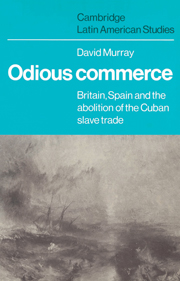Book contents
- Frontmatter
- Contents
- Tables
- Preface
- 1 The ‘opening’ of a legal trade
- 2 Parliament versus Cortes
- 3 Legality and illegality
- 4 The treaty of 1817
- 5 Enforcement and re-enforcement: the attempt to make the slave trade prohibition effective
- 6 The treaty of 1835
- 7 An abolitionist era
- 8 The Turnbull affair
- 9 The Escalera conspiracy
- 10 The penal law of 1845
- 11 Free trade and annexationism
- 12 The failure of the penal law
- 13 A new class of slaves
- 14 The abolition of the Cuban slave trade
- Abbreviations
- Notes
- Bibliography
- Index
- CAMBRIDGE LATIN AMERICAN STUDIES
7 - An abolitionist era
Published online by Cambridge University Press: 16 October 2009
- Frontmatter
- Contents
- Tables
- Preface
- 1 The ‘opening’ of a legal trade
- 2 Parliament versus Cortes
- 3 Legality and illegality
- 4 The treaty of 1817
- 5 Enforcement and re-enforcement: the attempt to make the slave trade prohibition effective
- 6 The treaty of 1835
- 7 An abolitionist era
- 8 The Turnbull affair
- 9 The Escalera conspiracy
- 10 The penal law of 1845
- 11 Free trade and annexationism
- 12 The failure of the penal law
- 13 A new class of slaves
- 14 The abolition of the Cuban slave trade
- Abbreviations
- Notes
- Bibliography
- Index
- CAMBRIDGE LATIN AMERICAN STUDIES
Summary
The abolition of slavery within the British empire in 1833 had a revolutionary impact on Britain's West Indian colonies, but the Caribbean effects of British humanitarianism were not confined to British colonies. The influence of British abolitionist ideas and subsequently of British abolitionists themselves spread quickly from Jamaica to Cuba, the nearest and largest of the remaining slave plantation colonies of the Caribbean. Cuban planters and Spanish colonial officials knew only too well that it had been British pressure on Spain to abolish the slave trade, after Britain herself had prohibited it, which had led to the Anglo-Spanish treaties of 1817 and 1835, prohibiting the slave trade to Cuba; the abolition of slavery within British colonial possessions portended a similar campaign to eliminate slavery in Cuba. Within Cuba abolitionism was viewed as a foreign import which, in the eyes of the European planter class and Spanish officials, was a foreign menace. In an ironic and unwitting interaction of British colonial and foreign policy, the emancipation of slaves in the British West Indies provoked a greater reaction in Cuba than the long and persistent effort of British officials to stop the Cuban slave trade.
The Cuban government, supported every step of the way from Madrid, took all possible precautions to prevent abolitionist ideas from seeping into the island. Beginning in the late 1820s as the campaign against slavery in the British empire began to gather force, Cuban authorities enacted a series of measures designed to guard the island against this intangible enemy.
- Type
- Chapter
- Information
- Odious CommerceBritain, Spain and the Abolition of the Cuban Slave Trade, pp. 114 - 132Publisher: Cambridge University PressPrint publication year: 1981

